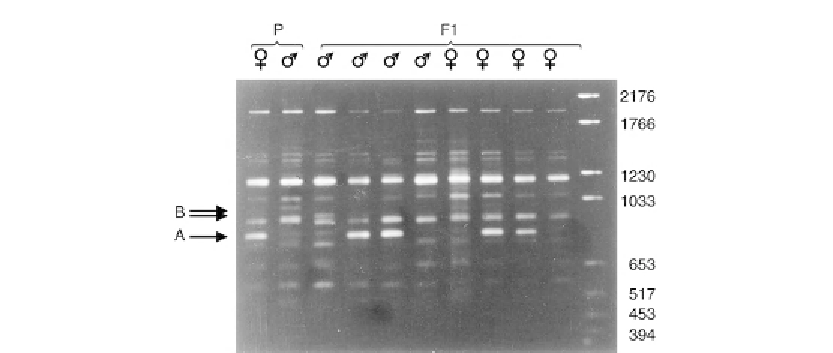Biology Reference
In-Depth Information
Figure 8.6
Photograph of a gel showing mode of inheritance of RAPD-PCR DNA fragments from
the parasitic wasp
Trioxys pallidus
. A single 10-mer primer anneals to different regions of the genome
and if two primers anneal in the opposite orientation, amplification of several DNA sequences
occurs. The size marker on the right lane indicates the size of the bands. Arrow A indicates the band
in the mother is inherited in approximately half of her haploid male and diploid female progeny,
which is consistent with the hypothesis that the mother was heterozygous for this band. Arrow B
identifies faint bands that are not inherited in a Mendelian manner and are not used in analyses
(
Edwards and Hoy 1994
).
be detected as bands in ethidium bromide-stained agarose gels (
Figure 8.6
). This
modified PCR method was called
RAPD-PCR
because it produced
R
andom
A
mpliied
P
olymorphic
D
NA bands.
RAPD-PCR has been used to develop genetic maps and to identify molecular
markers in populations or species, as well as determine paternity in dragonflies
(
Hadrys et al. 1992, 1993; Tingey and del Tufo 1993; Schierwater 1995
). RAPD-
PCR makes it possible to identify hundreds of new markers in a short time,
which allows genetic maps to be developed rapidly. RAPD-PCR is particularly
valuable for genome mapping in those species for which other genetic markers
are lacking or rare (
Laurent et al. 1998
).
Genomic DNA sequences differing by only a single base may not be ampli-
fied in the RAPD protocol, or they may result in a complete change in the num-
ber and size of the amplified DNA segments. Thus, RAPD-PCR may detect small
differences in the genomes of individual arthropods, different populations, or
species. RAPD fingerprinting can be carried out on very small arthropods, such
as single aphid embryos, while preserving the mother for morphometric or
karyotyping analyses (
Chan et al. 1999
) and is especially useful for discriminat-
ing between tiny parasitoid species or biotypes (
Edwards and Hoy 1993, 1994;

